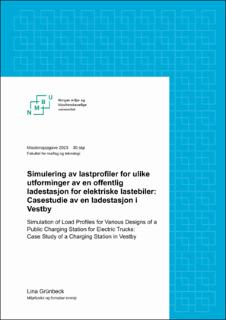| dc.contributor.advisor | Heidi S. Nygård (hovedveileder) | |
| dc.contributor.advisor | Stig Ø. Ottesen (biveileder) | |
| dc.contributor.author | Grünbeck, Lina Bodil | |
| dc.date.accessioned | 2023-09-21T16:27:20Z | |
| dc.date.available | 2023-09-21T16:27:20Z | |
| dc.date.issued | 2023 | |
| dc.identifier | no.nmbu:wiseflow:6866378:55030715 | |
| dc.identifier.uri | https://hdl.handle.net/11250/3091164 | |
| dc.description.abstract | Tungtransporten står for en stor andel av Norges årlige klimagassutslipp. Elektrifiseringen av lastebiler kan være med på å redusere CO2 utslippene, men manglende ladeinfrastruktur er en barriere. Det trengs derfor nye offentlige hurtigladestasjoner tilrettelagt elektrisk tungtransport. Transportselskapet ASKO skal elektrifisere lastebilparken sin, og utreder derfor en offentlig ladestasjon for elektriske (el.) lastebiler i Vestby. Det eksisterer derimot lite kunnskap om hvordan det fremtidige effektforbruket vil se ut.
Det har tidligere blitt utviklet metoder for å undersøke effektforbruket ved ladestasjoner for el. lastebiler. Ingen er derimot generelle nok til å kunne tilpasses ulike områder i Norge, og samtidig detaljerte nok til å kunne ta hensyn til forskjellige utforminger av ladeinfrastrukturen. Denne oppgaven har derfor utviklet et rammeverk for å estimere den fremtidige lastprofilen til den konseptuelle ladestasjonen i Vestby for ulike scenarier.
For å estimere lastprofilene ble det utviklet en generell simuleringsmodell av en ladestasjon, samt en utvidelse av modellen for fleksibilitet fra en batteribank. Modellparameterne ble tilpasset oppgavens case med utvalgte verdier og dataanalyser av trafikkdata og stopptider for lastebiler. For å reflektere usikkerheten i modellens estimater ble det gjennomført Monte Carlo-simuleringer. Gjennom en parameteranalyse ble lastprofilene undersøkt for ulike utforminger av ladeinfrastrukturen ved ladestasjonen, både med og uten fleksibilitet fra ulike batterikonfigurasjoner.
Resultatene for de estimerte lastprofilene ga et maksimalt effektforbruk på 1,3-2,1MW for simuleringene uten fleksibilitet. Formen på lastprofilene viste at el. lastebilene til ASKO stod for det mest ugunstige effektforbruket, mens forbruket fra andre aktører var mindre utfordrende for nettkapasiteten. Videre tilsa parameteranalysen at mellom 5 og 15 ladestolper med 350kW ladeeffekt vil gi den beste utnyttelsen av de undersøkte ladeinfrastrukturene, og at en investering i 1000kW ladeeffekt ikke vil lønne seg for det simulerte ladebehovet. Et lavere antall ladestolper førte derimot til ventetider ved ladestasjonen.
Simuleringene med batterifleksibilitet ga lastprofilene en 2,7-27,7% reduksjon i maksimalt effektforbruk for ulike konfigurasjoner, der en stasjonær batteribank med 1500kWh/1000kW utforming ga den høyeste reduksjonen. Basert på analysene var batteribankens kapasitetsutnyttelse lav for denne utformingen, og lastprofilene viste at en dynamisk opp- og utladingsgrense for batteribanken ville økt utnyttelsen. | |
| dc.description.abstract | The carbon emissions from heavy-duty transport make a significant contribution to the annual CO2 emissions in Norway. The electrification of trucks can help reduce the emissions, but the limited availability of charging infrastructure is a barrier. New public fast-charging stations suited for electric heavy-duty transport are therefore needed. The transport company ASKO is in the process of electrifying its truck fleet and is therefore investigating the possibility of a public charging station for electric trucks in Vestby. However, there is limited knowledge about the future power consumption that is to be expected from the station.
Multiple methods have previously been proposed to assess the power consumption of charging stations for electric trucks. However, none of them are easily adaptable to different regions in Norway, while also being customizable for a range of charging station designs. Hence, this study has developed a framework to estimate the future load profiles of the conceptual charging station in Vestby for various scenarios.
To estimate the load profiles, a general simulation model of a charging station was developed, along with an extension to incorporate flexibility from a battery bank. The parameters in the model were adapted to the case study by using selected values and data analysis of traffic data and common stop locations for trucks. Monte Carlo simulations were used to account for the uncertainty in the model. The load profiles were examined for different designs of the charging infrastructure by using a parameter analysis that was carried out with and without flexibility from various battery bank configurations.
The estimated load profiles showed a peak power consumption of 1.3-2.1MW for the simulations without flexibility. The shape of the load profiles indicated that the electric trucks from ASKO accounted for the most demanding power consumption, while the consumption from other trucks was less challenging for the power grid capacity. Furthermore, the parameter analysis suggested that between 5 and 15 charging points, with four power outlets each, would provide the best utilization of the investigated charging infrastructures. It was also shown that it is not worth investing in 1000kW charging power compared to 350kW for the simulated charging needs. At the same time, a lower number of charging points resulted in waiting times at the charging station.
Simulations with flexibility from a stationary battery bank reduced the peak power consumption in the load profiles by 2.7-27.7% for various configurations, where a battery bank with a 1500kWh/1000kW specification gave the highest reduction. Based on the analyses, the utilization of the battery bank capacity was low for this configuration, and the load profiles indicated that a dynamic charging and discharging limit for the battery bank would increase its utilization. | |
| dc.language | nob | |
| dc.publisher | Norwegian University of Life Sciences | |
| dc.title | Simulering av lastprofiler for ulike utforminger av en offentlig ladestasjon for elektriske lastebiler: Casestudie av en ladestasjon i Vestby | |
| dc.type | Master thesis | |
